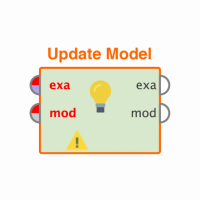Due to recent updates, all users are required to create an Altair One account to login to the RapidMiner community. Click the Register button to create your account using the same email that you have previously used to login to the RapidMiner community. This will ensure that any previously created content will be synced to your Altair One account. Once you login, you will be asked to provide a username that identifies you to other Community users. Email us at Community with questions.
Can we implement Multi-input Model with Rm?
I wonder if it is possible to implement Multi-input Model with Rm.
For example, assuming that you are creating a price prediction model, you would like to receive the product's image and time series data, train them as CNN and LSTM models, respectively, and then merge the two models.
Of course, it should be possible to save the model and classify it later when images and time series data are added.
I tried to find the model side with 'concat' or 'merge', but it failed and it doesn't come up in the google search either.
please answer about my question. thank you
0
Best Answer
-
 vivek101
Member Posts: 8
vivek101
Member Posts: 8  Contributor II
Hi,Recurrent neural networks (RNNs) may be used to create multi-input models, hence the answer is yes. many input sequences can be handled by recurrent models like the RNN, LSTM, or GRU by accepting input tensors with many dimensions.You may create a multi-input model in the context of deep learning frameworks like TensorFlow or PyTorch by specifying many input layers, each of which corresponds to a separate input sequence. These input layers can be linked to different network branches, enabling the model to recognize and handle each input sequence separately.RNNs are often used to implement a multi-input model, and the basic processes are as follows:1. Establish the input layers. For each input sequence, make a unique input layer. Each input should have its form and data type specified.2. Handle each input sequence individually: Use the proper preprocessing techniques, such as embedding or one-hot encoding, to encode the input sequences in a way that the RNN can understand.3. Develop the model's architecture: Create the desired layers, such as the RNN layers or any other layers, and link them to the associated input layers. Create the architecture such that it can capture the necessary connections and interactions among the input sequences.4. Compile the model: Indicate any required metrics for model training, as well as the optimizer and loss function.5. Train the model: Using backpropagation and gradient descent methods, refine the model's parameters based on the training data. Improve performance by adjusting the hyperparameters, such as learning rate and batch size.6. Review and improve the model: Evaluate the model's effectiveness on a different validation or test set. To enhance the performance of the model, make any necessary modifications to the architecture, hyperparameters, or data pretreatment methods.Keep in mind that for thorough instructions on how to create multi-input models using RNNs, you need to consult the relevant documentation and APIs of the deep learning framework you are using. These frameworks offer a variety of utilities and functions to make the development and training of such models easier.0
Contributor II
Hi,Recurrent neural networks (RNNs) may be used to create multi-input models, hence the answer is yes. many input sequences can be handled by recurrent models like the RNN, LSTM, or GRU by accepting input tensors with many dimensions.You may create a multi-input model in the context of deep learning frameworks like TensorFlow or PyTorch by specifying many input layers, each of which corresponds to a separate input sequence. These input layers can be linked to different network branches, enabling the model to recognize and handle each input sequence separately.RNNs are often used to implement a multi-input model, and the basic processes are as follows:1. Establish the input layers. For each input sequence, make a unique input layer. Each input should have its form and data type specified.2. Handle each input sequence individually: Use the proper preprocessing techniques, such as embedding or one-hot encoding, to encode the input sequences in a way that the RNN can understand.3. Develop the model's architecture: Create the desired layers, such as the RNN layers or any other layers, and link them to the associated input layers. Create the architecture such that it can capture the necessary connections and interactions among the input sequences.4. Compile the model: Indicate any required metrics for model training, as well as the optimizer and loss function.5. Train the model: Using backpropagation and gradient descent methods, refine the model's parameters based on the training data. Improve performance by adjusting the hyperparameters, such as learning rate and batch size.6. Review and improve the model: Evaluate the model's effectiveness on a different validation or test set. To enhance the performance of the model, make any necessary modifications to the architecture, hyperparameters, or data pretreatment methods.Keep in mind that for thorough instructions on how to create multi-input models using RNNs, you need to consult the relevant documentation and APIs of the deep learning framework you are using. These frameworks offer a variety of utilities and functions to make the development and training of such models easier.0

 Maven
Maven